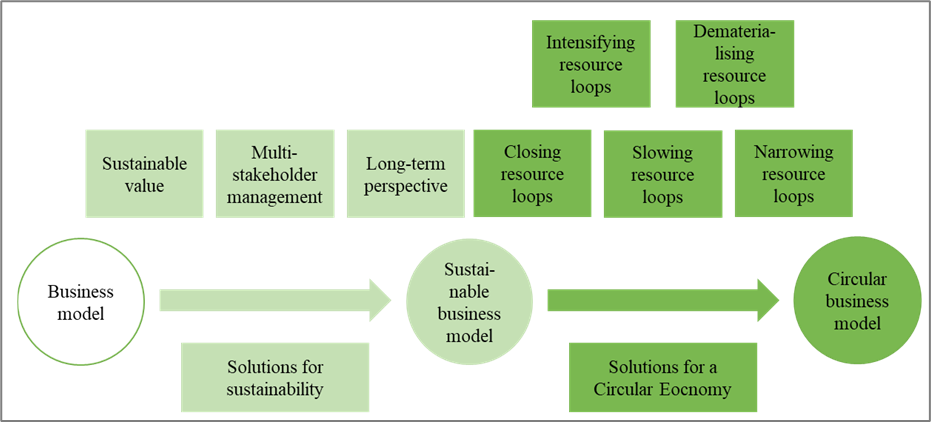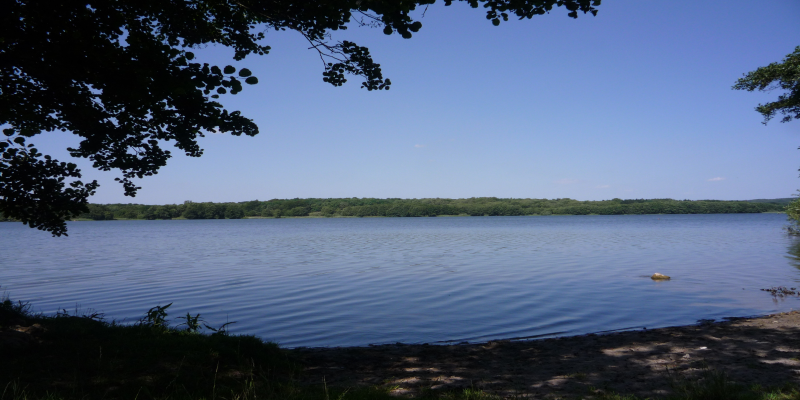Companies that are seriously dealing with the topics of climate change and sustainability will sooner or later need to re-launch their business model. When all “low-hanging fruits” are picked a company has no choice but to dig deeper and find more ways to fulfil their climate goals, implement their climate strategy and complete their reduction measures. This is not only to be seen as a challenge but as a chance. Generally, business models describe the rationale of how an organization creates, delivers and captures value. Establishing a sustainable business model is one opportunity to adapt sustainable solutions such as a circular supply chain. In a circular supply chain, the different organisational units of a company cooperate, communicate and configure across their business units and organisational functions in order to close energy or waste loops, reduce resource consumption and leakages and work together towards sustainable competitive advantages.
In short, Circular Economy (CE) is about creating closed loop material flows keeping products, components and materials at their highest utility and value and use them through multiple lifecycles. It is also about waste prevention, resource efficiency, leakage minimisation and dematerialisation: Raw materials are added for manufacturing and re-manufacturing of products or components already in the system. These have been recycled or re-used by the consumer maybe several times already. Waste is almost non-existent but only leaves the system as residual waste if no further use is possible. CE opens the doors for innovative actors, it can create new businesses and markets, create jobs and make room for creative product innovations fit for closed loop material flows.
A sustainable business model is a business model that incorporates pro-active multi-stakeholder management, the creation of monetary and non-monetary value for a broad range of stakeholders, and which holds a long-term perspective. Including non-monetary values and a long-term perspective are a key differentiation for sustainable businesses. It enables companies to create sustainable competitive advantage and build resilience to the several strategic challenges. From a sustainable business model companies can develop further towards a circular business model which narrows resource loops and lead to sustainable resource efficiency.
Accenture [1] has identified five business models that are supportive of a successful transition from a conventional business model to because they fully, or in parts, contribute to the circular economy concept:
- Circular Supplies: Instead of using pollutive raw materials this business model focusses on using renewable energy, bio- or fully degradable resources for consecutive lifecycles.
- Resource Recovery: This business model forms a production and consumption system that can recycle, reuse and recover resources and energy. It also asks for a fully working return chain that can recapture end-of-life products and put waste created to use for other purposes.
- Product Life Extension: Companies become enabled to extend their assets and product lifecycles and maintain values longer. Products are designed for repairability, durability, upgradability or recyclability. This model also needs a reverse logistics system in place to reuse, disassembly or recycle a product after it is no longer functional or economically useful.
- Sharing platform: With this business model cooperation and collaboration amongst product users are promoted for sharing overcapacity or underutilisation to maximise product utilisation.
- Product as a service: This business model offers an alternative to “buy and own” as products are used by one or even more customers by a leasing or pay-per-use principle. The value of a product is not measured by volume but by performance instead.
The figure below illustrates the possible shifts companies can make.

In order to develop a sustainable business model a company can begin to include the aspects of sustainable values, pro-active stakeholder engagement and a long-term perspective as pointed out in the definition of sustainable business models. The next step is moving towards a circular business model that describes the rationale of how an organization creates, delivers and captures ecological, social and economic value that is restorative and regenerative by intent. It adds the important closing, slowing down or narrowing of the several loops such as waste, energy and resources. This is only one presentation of how a business might chose to move into a circular direction. Business models must, however, be considered in the CE discussion and in a successful transition.
The DFGE can support you in many steps on the way to a sustainable or even circular business model. With regard to product design the DFGE can support you in evaluating the environmental impact of a product. Additionally, the DFGE can support you in estimating comparative emissions: what is the emission impact of your conventional product in comparison to a redesigned product. As a long standing CDP Partner the DFGE can, of course, also support you if you wish to join the companies disclosing with CDP, check your gaps and improve your rating. If you have further questions, please contact us via or by phone at +49 8192-99733-20.
To learn more you are welcome to download our comprehensive White Paper called „Closed-loop value chains: how to move towards a circular business model„.
[1] Accenture, “Circular Advantage – Innovative Business Models and Technologies to Create Value in a World without Limits to Growth”, 2019-04-02, available at https://www.accenture.com/t20150523T053139__w__/us-en/_acnmedia/Accenture/Conversion-Assets/DotCom/Documents/Global/PDF/Strategy_6/Accenture-Circular-Advantage-Innovative-Business-Models-Technologies-Value-Growth.pdf









